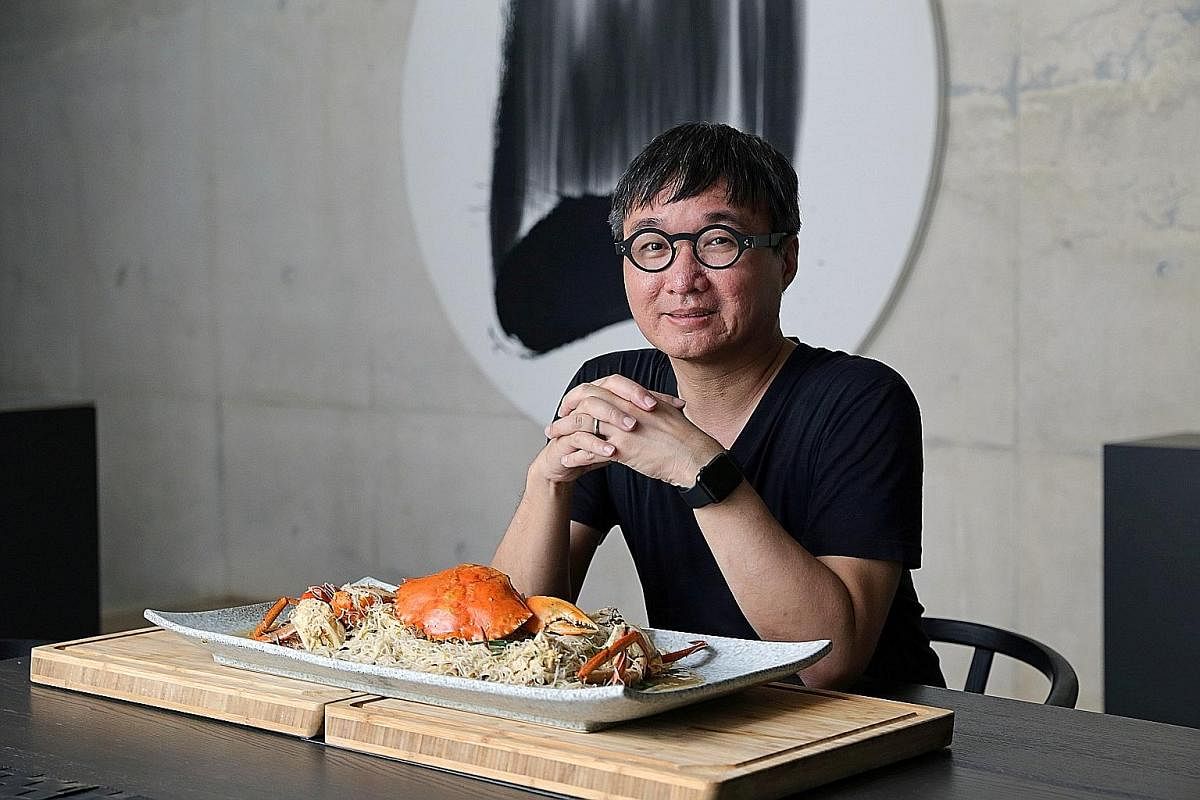-
-
CRAB BEE HOON
INGREDIENTS
2 Sri Lankan mud crabs (about 700g each)
450ml vegetable oil
300g bee hoon, soaked in tap water for 30 minutes
460ml water
200g beansprouts
2 pieces garlic, minced finely
3 slices ginger, sliced to 1cm thick
500ml store-bought chicken stock
1 Tbs light soya sauce
1 Tbs corn starch
1 Tbs hot water
Spring onions cut to 4cm-long, salt, sliced chilli and white pepper to taste
METHOD
1. To kill the crab, turn it over and use a cleaver to open a triangular flap at the bottom. Place the cleaver in the centre and use a mallet to hammer it until the crab is sliced into half without breaking its shell. Rinse crab under running water.
2. Untie string around the pincers and use a cleaver to chop off both pincers. Set aside.
3. Grab a bunch of crab legs in each hand and break the crab from the main shell to reveal gills (below). Slice off the gills with a cleaver and discard them. Chop each of the two crab portions in half.
4. Drain excess water from the shell and remove white membrane inside. Discard.

5. Use a mallet to crack the pincers slightly. Set aside.
6. Scrub off mud and dirt at the side of the shell. Set aside.
7. In a wok set over high heat, add 200ml vegetable oil and swirl it around the wok to grease it. Heat up the oil for two to three minutes.
8. Add bee hoon. Fry 5 to 10 minutes till it is lightly charred. Remove from wok and set aside.
9. In the same wok, add another 200ml of vegetable oil and crab pieces, starting with the pincers and shell, as they take a longer time to cook.
10. Cook for about three minutes till the shell and claws turn red. To cook each part, tilt the wok so that the crab pieces are closest to the fire.
11. Add remaining crab pieces into the wok and stir in 100ml of water. Cover the wok and cook for about eight minutes. Remove crab from wok. Set aside.
12. In the same wok, add 50ml of vegetable oil and 360ml of water. Add bean sprouts, minced garlic, ginger slices and bee hoon that was fried earlier. Stir-fry for five minutes.
13. Pour 500ml chicken stock into the wok and add pre-cooked crab pieces. Stir-fry for five minutes.
14. Add 1 Tbs of light soya sauce and a mixture of 1 Tbs of corn starch and 1 Tbs of hot water into the wok. Fry contents for about one to two minutes until the gravy thickens. Add sliced spring onions and salt to taste.
15. Scoop onto a large platter. Garnish with sliced chilli and white pepper. Serve.
Serves four
-
Singapore Cooks
A recipe for crab bee hoon with wok hei
Architect Edmund Ng liked the crab bee hoon at a Geylang eatery so much he tried to recreate it





From towering piles of bright yellow nasi kuning rice paired with 20 sides such as rendang and chicken and beef rendang to heaps of stir-fried noodles that feed 30 people, architect Edmund Ng relishes cooking in mammoth portions.
The 44-year-old's cooking prowess is so well known among friends that he gets requests to cook for large gatherings of 50 to 150 people once every three months in his 21/2-storey bungalow in Siglap.
To accommodate his guests, he has a 6m-long, 22-seat dining table that spans his industrial-chic living room, which is peppered with artworks.
In the kitchen, there are two food racks slotted with large trays, which are typically found in professional kitchens. He uses these trays to store mountains of fresh and pre-cooked ingredients for dishes that require multiple cooking steps.
The self-taught cook says: "I like cooking in large amounts. When more ingredients are used, they make the stock and the flavours of the food more rich and intense."
Mr Ng whips up one of his most scrumptious feasts on Chinese New Year.
He and his wife, Jazz Chong, who owns Ode To Art gallery in Raffles City, hosts two large gatherings for family and friends at their home. The couple have a 1-1/2-year-old son.
One of Mr Ng's festive must- cooks is crab bee hoon. He shares the recipe here.
The stir-fried crab bee hoon has wok hei-redolent bee hoon in a piquant chicken stock that has been infused with the crustacean.
Mr Ng uses Sri Lankan mud crabs as they have "a good amount of firmer and sweeter meat" and he usually includes both male and female crustaceans as the female has silky and umami-rich yellow roe and the male boasts firmer meat.
One of the trickier parts of cooking the dish is to ensure that the crabs are not overcooked.
Mr Ng says: "The meat should be firm yet moist, so you have to ensure that it doesn't turn opaque and too dry."
His interest in cooking crab bee hoon was sparked after having the dish at Bib Gourmand-award- winning Sin Huat Seafood Restaurant in Lorong 35 Geylang 11/2 years ago.
He recalls: "The dish was so nice, but it was too expensive, so I wanted to challenge myself to re-create it at home. I observed the chef frying the noodles in his open-concept kitchen, looked at the tell-tale signs such as the brand of soya sauce he used and inspected the ingredients on the plate. It was like doing CSI (crime scene investigation) work."
He reckons that he has achieved 80 per cent of the taste of the crab bee hoon at Sin Huat.
"My ingredients for the sauce are pretty basic," he says. "Sin Huat's crab gravy is quite flavourful. I have not figured out what goes into it."
This Chinese New Year, which falls on Saturday, he will be cooking up a storm for reunion dinner and will host an open house which will be attended by about 150 people.
Other buffet-style dishes that he will be cooking include Hokkien mee and roast pork belly (siew yoke).
"From ordering gigantic portions of ingredients a week beforehand to buying seafood on the morning of the gathering, the preparation work is fun and puts me in a festive mood," he says, shrugging off any suggestion of tiredness that comes with cooking for big events.
Growing up, Mr Ng "had no opportunity to interfere in the kitchen" as his mother did the cooking.
Over the years, he devoured cook books by British chef Heston Blumenthal and started cooking actively only 21/2 years ago when he moved into his current home.
"My transition from a theoretical to practical chef happened very quickly and my parents were surprised that I could cook."
He enjoys cooking Chinese cuisine most. In fact, his love for zi char dishes spurred him to splurge $400 on an industry-grade kitchen gas stove one year ago so that he could create the wok hei fragrance with the intense heat and bring out umami flavour in dishes, such as char kway teow and Hong Kong- style steamed fish.
Mr Ng, who runs his eponymous architecture firm, also had his interest in food piqued while designing the interiors of restaurants.
"Cooking is similar to architecture. There is a lot of emphasis on visual appearances. Both require observation and learning of techniques to construct a good end- product".
Join ST's Telegram channel and get the latest breaking news delivered to you.
A version of this article appeared in the print edition of The Sunday Times on January 22, 2017, with the headline A recipe for crab bee hoon with wok hei. Subscribe

